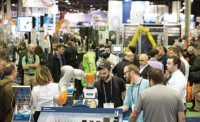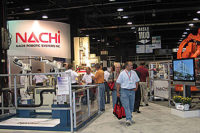More than 5,000 manufacturing professionals saw the latest robots, fastening tools and automation at the seventh annual ASSEMBLY Show, which was held Oct. 22-24 at the Donald E. Stephens Convention Center in Rosemont, IL.
The show featured 308 exhibitors spread across 86,800 square feet of floor space. Some 80 percent of the 2019 exhibitors renewed their booth space on-site for the 2020 show.
“We received very positive feedback from the attendees, who truly appreciate that our show focuses exclusively on assembly and the opportunity to see the newest equipment and technology for them to bring back to their companies,” says Tom Esposito, publisher of ASSEMBLY Magazine. “Over the past seven years, we have doubled the size of our exhibit hall and expanded our attendee base, and we thank our exhibitors, attendees, sponsors and partners for their hard work and dedication in making this year’s ASSEMBLY Show an important industry gathering.”
Some 7,400 industry professionals from across the United States and around the world registered to attend the show. Attendees came from every industry covered by ASSEMBLY magazine, including such companies as AGCO, A.O. Smith, Baxter Healthcare, Briggs & Stratton, Ethicon, Fiat Chrysler, General Motors, Hella, Kawasaki Motors, Lennox Industries, Lockheed Martin and Magna International.
The event kicked off with two workshops that attracted hundreds of attendees. Panelists for “The Factory of the Future” workshop discussed how assemblers can navigate the brave new world of data analytics, artificial intelligence, augmented reality, generative design and other cutting edge technologies. Panelists for “The Transitioning from Manual to Automated Assembly” guided engineers through the process and expanded upon how to pick the best projects, justify the investment, and design a line for maximum efficiency.
Editors from ASSEMBLY Magazine led dozens of attendees on five guided exhibit hall tours. Senior editor Austin Weber led the “Lean Manufacturing” and “Factory of the Future” tours; chief editor John Sprovieri led the “Robotics” and “Fastening and Joining” tours; and senior editor Jim Camillo led the “Automated Assembly” tour.
Subject matter experts from more than a dozen exhibitors gave presentations at the show’s Learning Theaters in the exhibit hall. The sessions, which averaged 50 attendees, covered topics such as traceability in production, designing for automation, the connected factory, optimizing helium usage, collaborative robots, and automated assembly.
During the opening night “Taste of Rosemont” reception, high school students from local FIRST Robotics programs demonstrated the robots they built, which use technology that is applicable for assembly. FIRST—For Inspiration and Recognition of Science and Technology—is an international high school program that gives students real-world engineering experience.
Keynote Discusses Future of Manufacturing
Digital manufacturing. The smart factory. Industry 4.0. For some manufacturers, these are merely the latest buzzwords—a lot of talk, but not much substance.
That is not the case at Ford Motor Co. The automaker has been building intelligent and connected manufacturing processes for the past several years. Now, advances in computing power, affordable automation and process sensing are enabling the company push even further, leveraging state-of-the-art production tools and processes to build the vehicles of tomorrow.
Ford has invested significantly in creating an advanced manufacturing organization, co-locating thought leaders from across the company into a new Advanced Manufacturing Center, which opened in December 2018. The center’s goal is to drive standard and scalable technologies into Ford’s products and plants to ensure that the company remains a leader in manufacturing efficiency.
Located in Redford, MI, the $45 million, 100,000-square-foot Advanced Manufacturing Center is packed with cutting-edge technologies, including drones, exoskeletons, mobile robots and vision systems. Engineers are also exploring new ways to deploy additive manufacturing, augmented reality and collaborative robots on the factory floor.
Michael Mikula, chief engineer for advanced manufacturing at Ford, oversees the center and delivered a thought-provoking keynote address to a standing room only crowd of 315 people. Mikula discussed how Ford is developing connected and intelligent manufacturing processes.
“Fundamentally, our priorities haven’t changed,” said Mikula, who began his career at Ford in 1994 as a tooling and process engineer in the casting division of the company’s power train operations, supporting foundries in Cleveland and Windsor, Ontario. “We still organize ourselves around the following priorities: safety, quality, delivery, cost, people, maintenance and environment. We have some 80 plants globally, thousands of workers, and when we originally talked about digitizing our manufacturing operations and moving toward Industry 4.0, there was a perception that we would abandon these priorities.
“Nothing could be further from the truth. Everything we are doing in leveraging Industry 4.0 is based on those priorities.”
Mikula explained that, to get the most from Industry 4.0 technologies, companies should build on a standard controls architecture. “In the ’90s, we often allowed suppliers to have a tremendous amount of influence over how controls architectures were set up at our plants,” he recalled. “That minimized our ability to evaluate operations from plant to plant or even within a plant. So we created a set of global standards, and that was critical to achieving scaled results.”
Data analytics is a major focus of the new center. There, manufacturing engineers and data scientists are working together to solve problems. “We have a manufacturing analytics team that does all the triage work for our plants, looking at their pain points and developing projects for our data scientists, who are not that savvy about manufacturing. So, my team helps translate those pain points into executable data science solutions.”
Prior to the keynote address, representatives from GE Appliances’ refrigerator factory in Decatur, AL, received the Assembly Plant of the Year Award from ASSEMBLY Magazine.
Product of the Year Winners
To draw attention to the breadth and quality of new technologies on display at The ASSEMBLY Show, we again held a “Product of the Year” contest during the event.
Twenty innovative products were nominated in five categories. Attendees voted for their favorites via tablet computers at a special display on the show floor. Voting was open during the first two days of the show, and the winners were announced the morning of Thursday, Oct. 24.
In the “Assembly Machines and Systems” category, the winning product was the SuperTrak Micro from ATS Automation Systems Inc.
The SuperTrak Micro is a linear-motor-based conveyance platform for flexible, high-speed production systems. Built on the SuperTrak Gen3 foundation, the platform provides multiple advantages for automated assembly, including high transfer speeds; precise control of acceleration and deceleration; accurate positioning; the ability to move product forward and backward on the line; and independent control over individual pallets.
Pallets can carry a maximum payload of 1.5 kilograms. Maximum pallet speed 4 meters per second, and maximum pallet acceleration is 1.5 g with a 1.5-kilogram payload or 5 g with a 0.25-kilogram payload. Whereas Gen3 has a minimum pitch of 155 millimeters, SuperTrak Micro has a minimum pitch of 50 millimeters. A unique feature of SuperTrak Micro is the divert-and-merge function, which enables the machine to seamlessly hand-off individual pallets to neighboring Micros without stopping or even slowing down.
In the “Adhesives, Dispensing and Curing” category, the winning product was the Re Mixer I disposable mixing nozzle from Re Mixers Inc. The nozzle mixes two-part adhesives in less than half the length of existing options. This means half the adhesive waste, increased operator dexterity, and greater positional accuracy in automated meter-mix systems. The mixer is produced with advanced 3D printing technology. Recursive computer simulation was employed to derive its unique shape.
In the “Fastening Tools” category, the winning product was the EABS right-angle nutrunner from Desoutter Industrial Tools. This lightweight tool enables an assembler to tighten fasteners in cramped spaces with one hand, so he can use the free hand to support himself or hold other components out of the way.
For greater versatility and comfort, the tool is battery powered, ergonomically designed and weighs just 2 pounds. It is 11 inches long, tightens fasteners up to 24 newton-meters and can run at more than 1,000 rpm. To further boost productivity, the nutrunner can be paired with the company’s wireless Connect smart hub for applications where traceability is essential. Pairing takes less than 10 seconds.
In the “Robotics” category, the winning product was the VT6L six-axis robot from EPSON Robots. Economical and easy to install, the robot is ideal for a wide range of simple parts-transfer applications. These include loading and unloading machine tools or injection molding machines, pick-and-place applications, and adhesive dispensing.
The robot’s built-in controller saves on valuable factory space, while its SlimLine design features a compact wrist pitch that enables access to hard-to-reach areas in confined spaces. The robot has a maximum reach of 900 millimeters, and it can carry a maximum payload of 6 kilograms. A hollow wrist allows for simplified cabling and versatile tooling. The robot works off 110- or 220-volt power and can be installed in minutes. Its encoder requires no battery, reducing the overall cost of ownership. Integrated vision guidance is optional.
In the “Factory of the Future” category, the winning product was the MARK Basic and MARK Standard Range wearable bar code scanners from ProGlove. The device is a glove equipped with matchbook-sized bar code scanner. Because workers don’t have to constantly pick up and put down handheld scanners, the gloves save up to 4 seconds per scan.
MARK Basic has a scanning range of 5 feet. It can be quickly hooked up to a corporate network via Bluetooth Low Energy (BLE) and comes with a “worker feedback” option. Through optic, acoustic and haptic alerts, workers know immediately if they have picked the right item. The device can scan 3,000 codes per charge. The MARK Standard Range lets users scan bar codes at a distance of up to 32 inches. It can scan 6,000 codes per charge. It is ideal for high-frequency scanning environments, such as assembly lines.
Next year’s ASSEMBLY Show will be held Oct. 27-29, 2020. For more information, visit www.theassemblyshow.com.














